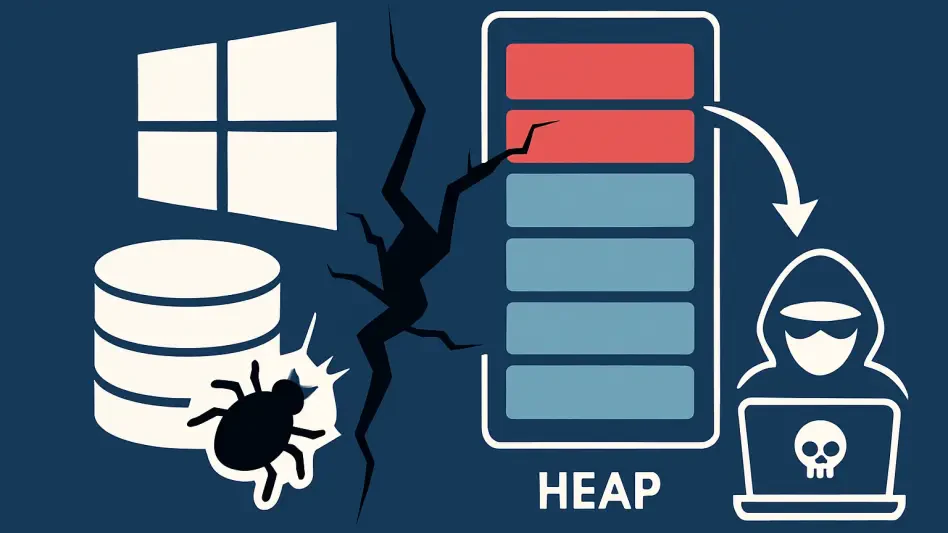In an era where cyber threats continue to evolve at an alarming pace, a recently uncovered critical vulnerability in Windows heap management has sent shockwaves through the cybersecurity community, highlighting the persistent challenges in securing operating systems against sophisticated exploits. This flaw, rooted in the improper handling of record-size fields, allows attackers to perform arbitrary memory read and write operations, potentially leading to full system compromise. The implications of such a vulnerability are profound, as it undermines the fundamental security mechanisms designed to protect sensitive data and system integrity. Discovered through detailed exploitation techniques, this issue exposes weaknesses in the Windows NT Heap structure, particularly within the Low Fragmentation Heap (LFH) mechanism. As organizations and individuals rely heavily on Windows systems for critical operations, understanding the nature of this vulnerability and the methods used to exploit it becomes paramount to safeguarding digital environments against malicious actors.
1. Understanding the Windows Heap Management Flaw
The foundation of this critical vulnerability lies in the architecture of the Windows NT Heap, which utilizes both FrontEnd and BackEnd allocators to manage memory allocations. The FrontEnd allocator, specifically the Low Fragmentation Heap (LFH), handles smaller allocations under 16KB, while the BackEnd allocator manages larger requests. A key aspect of LFH is its activation requirement of 18 consecutive allocations of similar sizes, which creates predictable memory layouts that attackers can manipulate. This predictability becomes a significant risk in applications using private heaps created via the HeapCreate() function, as these environments often lack the robust security mitigations found in default process heaps accessed through GetProcessHeap(). The core issue arises during record update functionality, where applications may reuse previous record sizes when processing new data, failing to account for discrepancies that could lead to exploitable conditions. Such oversight in heap management opens the door to severe security breaches, making it a critical concern for system administrators and developers alike.
Beyond the structural vulnerabilities, the exploitation of this flaw begins with deliberate activation of LFH through repeated allocations to establish controlled memory layouts. Attackers can manipulate the target->size field, which remains static during updates, creating heap overflow scenarios when incoming data exceeds the allocated boundaries. This overflow condition is not merely a theoretical risk but a practical gateway for malicious actors to gain unauthorized access to memory regions. By exploiting these overflows, attackers can overwrite critical data structures, paving the way for more advanced attacks. The reduced security measures in private heaps exacerbate this issue, as they lack the protective layers that mitigate such risks in standard heap implementations. This vulnerability underscores the need for stringent memory management practices and heightened awareness of how seemingly minor oversights in code can lead to catastrophic outcomes in real-world scenarios, emphasizing the importance of proactive security measures.
2. Exploitation Techniques and Arbitrary Memory Access
Delving into the specifics of exploitation, attackers leverage the predictable nature of LFH to achieve arbitrary read capabilities by filling UserBlocks and creating memory holes through strategic record removal. By reusing memory chunks with carefully crafted data structures, sensitive memory regions such as heap base addresses, ntdll base locations, and Process Environment Block (PEB) structures become accessible. This ability to read arbitrary memory locations is a significant breach of security, as it allows attackers to gather critical information that can be used for further exploitation. The technique hinges on exploiting the consistency of memory layouts post-LFH activation, demonstrating how a seemingly benign mechanism can be weaponized. Such capabilities highlight the sophistication of modern cyber threats, where attackers meticulously analyze system internals to uncover and exploit hidden weaknesses, posing a substantial challenge to defenders tasked with securing complex systems.
In addition to read capabilities, the vulnerability enables arbitrary write primitives through the manipulation of Windows chunk structures, specifically the FLink and BLink pointers in free chunks. By forging fake chunks and altering freelist pointers, attackers can target FILE structures with crafted objects, controlling fields like _base, _file, _flag, and _bufsiz. Specific flag combinations, such as _IOBUFFER_USER (0x0080) and _IOALLOCATED (0x2000), are used to bypass validation checks, allowing the setting of _base to target memory addresses and _file to stdin for writing arbitrary data to controlled locations. This write capability is often the final step before executing malicious code, as it enables attackers to modify system memory in ways that facilitate further compromise. The exploitation process culminates in constructing Return-Oriented Programming (ROP) chains using Windows APIs like ReadFile, VirtualProtect, and WriteFile to load and execute shellcode, showcasing the full extent of damage possible through this vulnerability.
3. Mitigation Strategies and Future Safeguards
Reflecting on the severity of this issue, it became evident that robust mitigation strategies were essential to counter the risks posed by such heap vulnerabilities. Organizations were urged to prioritize input validation to ensure that data processed by applications adhered to expected formats and sizes, preventing overflow conditions. Utilizing modern heap implementations with enhanced security features was also recommended to reduce the attack surface. Additionally, deploying comprehensive memory protection mechanisms proved critical in detecting and blocking unauthorized access attempts. These steps, when implemented diligently, significantly lowered the likelihood of successful exploitation, providing a layered defense against sophisticated attacks targeting Windows heap internals. The focus on proactive security measures underscored the importance of staying ahead of evolving threats through continuous improvement of system safeguards.
Looking back, the response to this vulnerability also emphasized actionable next steps for bolstering system security. Developers and IT teams were encouraged to regularly audit heap usage in applications, identifying and addressing potential weaknesses before they could be exploited. Adopting secure coding practices became a cornerstone of preventing similar issues, with an emphasis on validating record sizes during updates. Furthermore, staying informed about emerging threats and exploitation techniques was deemed vital for maintaining a robust security posture. By fostering a culture of vigilance and investing in advanced threat detection tools, organizations could better prepare for future challenges. The lessons learned from this incident served as a reminder that security is an ongoing journey, requiring constant adaptation to safeguard critical systems against the ever-changing landscape of cyber threats.








